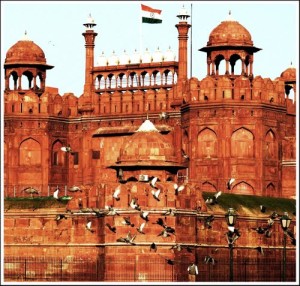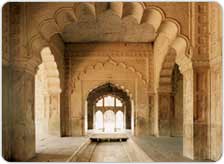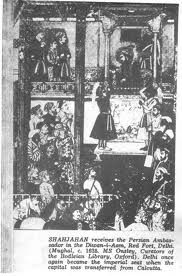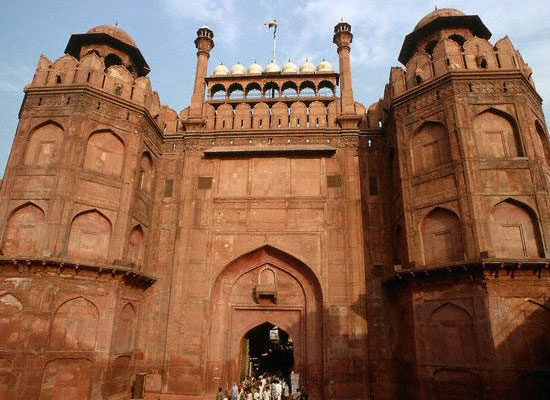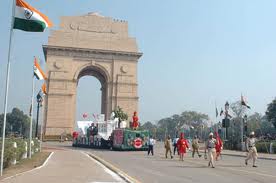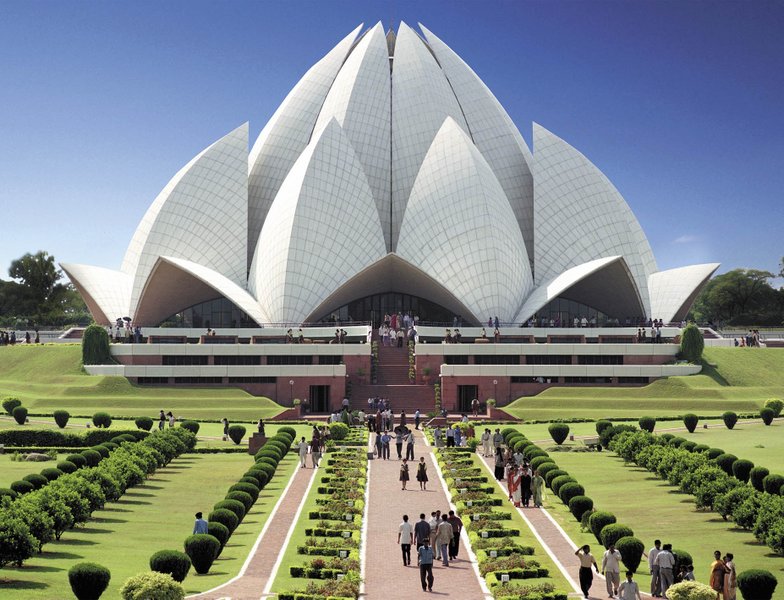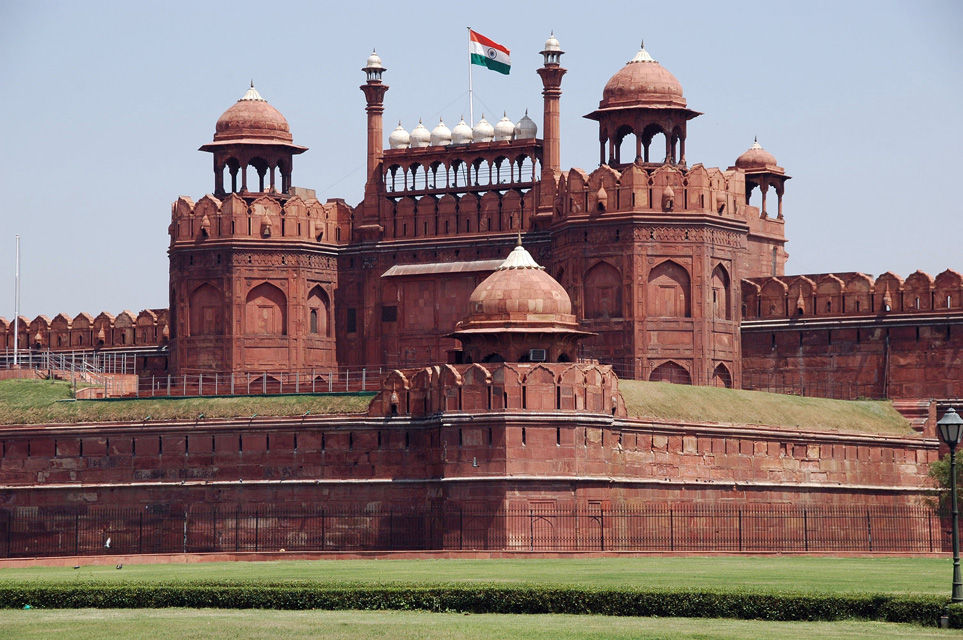Sight Address : Red Fort (Lal Qila),Chandni Chowk, Netaji Subhash Rd, New Delhi, DL 110006 Edit
Detail InformationEdit
Red sandstone walls of the massive Red Fort (Lal Qila) rise 33-m above the clamour of Old Delhi as a reminder of the magnificent power and pomp of the Mughal emperors. The walls, built in 1638, were designed to keep out invaders, now they mainly keep out the noise and confusion of the city.
The main gate, Lahore Gate, is one of the emotional and symbolic focal points of the modern Indian nation and attracts a major crowd on each Independence Day. The vaulted arcade of Chatta Chowk, a bazaar selling tourist trinkets, leads into the huge fort compound. Inside is a veritable treasure trove of buildings, including the Drum House, the Hall of Public Audiences, the white marble Hall of Private Audiences, the Pearl Mosque, Royal Baths and Palace of Colour.
An evening sound and light show re-creates events in India’s history connected with the fort.
HistoryEdit
Red Fort derives its name from the extensive use of red sandstone on the massive walls that surround the fort.Shah Jahan commissioned the construction of the Red Fort in 1638 when he decided to shift his capital from Agra to Delhi. Ustad Ahmad and Ustad Hamid were chosen as the architects for construction of the royal palace. Construction began in the auspicious month of Muharram on 13 May 1638. Construction of the fort was supervised by Shah Jahan himself and was completed in 1648.The Red Fort was originally referred to as “Qila-i-Mubarak” (the blessed fort), because it was the residence of the royal family.Unlike the other Mughal forts, layout of the boundary walls of the Red Fort is not symmetrical so as to retain and integrate the older Salimgarh Fort.The fortress palace was an important focal point of the medieval city of Shahjahanabad (present day Old Delhi). The planning and aesthetics of the Red Fort represent the zenith of Mughal creativity which prevailed during the reign of emperor Shah Jahan. Aurangzeb, Shah Jahan’s successor, added the Moti Masjid to the emperor’s private quarters and constructed barbicans in front of the two main gates, which made the entrance route to the palace more circuitous.The administrative and fiscal structure of the Mughals declined after Aurangzeb. The 18th century thus saw a degeneration of the palace and people of the Red Fort. When Jahandar Shah took over the Red Fort in 1712, the palace had been without an emperor for 30 years. Within a year of his rule, Jahandar Shah was murdered and replaced by Farukhsiyar. To combat the declining finances, the silver ceiling of the palace Rang Mahal was replaced by copper during this period. Muhammad Shah, who was also known as Rangila (the colourful) for his deep interest in arts, took over the Red Fort in 1719. In 1739, Nadir Shah, the Persian emperor, attacked the Mughals. The Mughal army was easily defeated and Nadir Shah plundered the Red Fort of its riches including the Peacock Throne. Nadir Shah returned to Persia after three months leaving a destroyed city and a weakening Mughal empire to Muhammad Shah.The internal weaknesses of the Mughal empire turned Mughals into titular heads of Delhi. A treaty signed in 1752 made Marathas the protector of the throne at Delhi.The Maratha conquest of Lahore and Peshawar in 1758,put them in direct confrontation with Ahmad Shah Durrani. In 1760, the Marathas removed and melted the Silver ceiling of the Diwan-i-Khas to generate funds for the defence of Delhi from the armies of Ahmed Shah Durrani.In 1761, after the Marathas lost the third battle of Panipat, Delhi was raided by Ahmed Shah Durrani. In 1771, Shah Alam ascended to the throne in Delhi with the support of the Marathas.In 1783, the Sikh Misl Karorisinghia, led by Baghel Singh Dhaliwal, conquered Delhi and the Red Fort. Sikhs agreed to restore Shah Alam as the emperor and retreat from the fort on the condition that Mughals would construct and protect seven historical Gurudwaras in Delhi associated with the Sikh gurus.Red Fort in Delhi, c. 1905. In 1803, during the Second Anglo-Maratha War, the forces of British East India Company defeated the Maratha forces in the Battle of Delhi, ending the Maratha rule over the city and their control over the fort.After the battle, British took over the administration of Mughal territories and installed a Resident at the Mughal courts in Red Fort.The last Mughal emperor to occupy the fort, Bahadur Shah II “Zafar”, emerged as a symbol of the 1857 rebellion against the British in which the residents of Shahjahanbad participated.Despite being the seat of Mughal power and its defensive capabilities, the Red Fort was not defended during the 1857 uprising against the British. After the failure of the rebellion, Zafar left the fort on 17 September. He returned to Red Fort as a prisoner of the British and was tried in 1858. He was exiled to Rangoon on 7 October of the same year.With the end of the Mughal reign, the British gave official sanctions to remove and sell valuables from the palace at the Red Fort. In 1863, British destroyed many buildings inside and outside the fort, filled up the gardens, stripped the fort of any valuable items and reduced the fort to just a military structure.16-7 After Indian Independence, the site experienced few changes in terms of addition or alteration to the structures. The Red Fort continued to be used as a cantonment even after Independence. A significant part of the fort remained under the control of the Indian Army until 22 December 2003, when it was handed over to the Archaeological Survey of India for restoration.
Must SeeEdit
Must see
Visiting TimeEdit
9 am – 6 pm
Closed OnEdit
N.A.
Best Season to VisitEdit
October to March
Best Time To VisitEdit
Morning, Afternoon & Evening
Time Required for SightseeingEdit
1:30 hrs To 2:0 hrs
Ticket Required : Yes Edit
Individual National Adult Rs. : Rs 10 (free on friday)
Kids Rs. : No Fee
Individual Foreigner Adult Rs. : Rs 250 (free on friday)
Kids Rs. : No Fee
Still Photo Camera Rs. : No Fee
Video Camera Rs. : Rs.25
Guide Required : No Edit
Approximate cost: N.A.
Dress Code (If Any) : No Edit
Dress Require: N.A.
Restaurants NearbyAdd / Edit
- Hotel Prince Polonia ; 2325-26, Tilak Street | Pahar Ganj, New Delhi 110055, India ; Ph/M – 011 4762 6600 ; Food Serve – N.A.
How to ReachEdit
Taxi : This place is well connected by road the taxi service is available for this destination. Call 40406060 to get cab at any place and to anywhere in Delhi. Price will be – Indica Vista (New) 10.00 Rs/ km, Indigo cs /Swift Dezire (New) 12 Rs/Km, Tavera (New) 13 Rs / km, Xylo (New) 13 Rs / km, Innova (New) 13 Rs / km, XUV-500 (New) 16.00 Rs/km, BMW (New) 80.00 Rs/km, Audi (New) 90.00 Rs/km, Honda City (New) 30.00 Rs/km, Tempo Traveller (New) 17.00 Rs/km, Corola (New) 30.00 Rs/km Honda-crv (New) 40.0Rs/km, Mercedes (New) 90.00 Rs/km.
Bus : Tourists can either take local buses from various points within the city to reach this sight, which is located in North Delhi.
Train : For foreigners, it’s easiest to make ticket bookings at the helpful International Tourist Bureau 23405156; 1st floor, New Delhi train station; 8am-8pm Mon-Sat, to 2pm Sun). Do not believe anyone – including porters – who tells you it has shifted, closed or burnt down and don’t let anyone stop you from going to the 1st floor of the main building for bookings. When making reservations here, if you are paying in rupees you may have to provide back-up money exchange certificates (or ATM receipts), so take these with you just in case.
Air : International and domestic flights all leave from and arrive at the airport’s gleaming new Terminal. For flight inquiries, call the international airport (0124-3376000; www.newdelhi airport.in). At the new Terminal 3 there are 14‘nap & go’ rooms with wi-fi, a desk, TV and bed (₹315/hr). For comprehensive details of domestic air routes, see Excel’s Timetable of Air Services Within India (₹55), available at news stands When making reservations request the most direct (quickest) route. Note that airline prices fluctuate and website bookings with some carriers can be markedly cheaper.
Jagson Airlines (23721593 Vandana Bldg, 11 Tolstoy Marg)
Kingfisher Airlines (23730238; 42N-Block, Connaught Place).
Others : METRO The new high-speed metro line is the best way to get to/from the airport, and runs between New Delhi train station and Dwarka Sector 21, via Shivaji Stadium, Dhaula Kuan NH8 (Mahipalpur station) and Indira Gandhi International station (Terminal 3). Trains operate every 10 minutes from 5am to 1am. Cycle-rickshaws are still in use in parts of Old Delhi, though they have been banned in Chandni Chowk to reduce congestion. Let’s hope they’re not banned in other areas, as they’re the best way to get around Old Delhi – the drivers are wizards at weaving through the crowds. Tips are appreciated for this gruelling work.
Things to CarryEdit
Carry a bottle of drinking water.
Safety / WarningEdit
Don’t flash jewellery or large sums of money and keep daily cash in separate pockets.
HelplineEdit
Fire – 101
Ambulance – 102
Child Helpline – 1098
Women Helpline Number : 1091
Accident & Trauma Service – 1099
Police Control Room Number : 100
Tourist City Information Service – 1286
